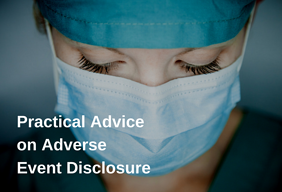
Why Disclose?
It is always in your patient’s best interest. When a patient experiences an unanticipated outcome or a medical error, he or she wants a representative from the organization involved to acknowledge the outcome or event, express sympathy, assume responsibility and apologize if any error occurred, and state that corrective actions will be enacted to ensure other patients do not experience similar outcomes.
It is also the ethically responsible thing to do. Disclosure is required by the Joint Commission standard RI.2.90. In addition, American Medical Association Code of Medical Ethics Opinion 8.121 requires physicians to “offer professional and compassionate concern toward patients who have been harmed,” emphasizing, among other things, that “[s]uch communication is fundamental to the trust that underlies the patient-physician relationship, and may help reduce the risk of liability.” Note that an expression of concern “need not be an admission of responsibility.”
Additionally, there is always an opportunity to learn and improve. Unanticipated outcomes need to be investigated to prevent, if possible, a recurrence in the future. A thorough investigation and analysis of all possible contributing factors is the first step in identifying and correcting system failures.
Lastly, disclosure has been shown to help avoid litigation and improve results. Several studies have found failure to provide explanations and poor communication generally are associated with litigation. Even if the patient still decides to sue after disclosure, the healthcare provider will be a more sympathetic defendant and is better insulated from a trial lawyer’s allegations of fraud and deceit.
How to Disclose
When relatively minor harm occurs, a discussion between patient and physician may be all that is necessary. However, for more severe errors that result in significant harm or even death, a more formal disclosure process is recommended. The following steps may serve as an initial framework for this process.
1. Manage the Patient’s Condition
The initial focus should be on the patient’s condition and ensuring that the necessary steps are taken to address the patient’s immediate clinical needs.
2. Contact Your Risk Manager, Practice Manager or Legal Counsel As Soon As Possible
These individuals will provide crucial assistance with careful and objective documentation of any medical facts in the medical record, along with preservation of any evidence, if applicable. In this immediate window after discovery of the harm, an explanation of how or why the event occurred should be deferred until an investigation is completed.
3. Prepare for the Disclosure Meeting
Convene a disclosure team to assist your preparation for the disclosure meeting. As a team, decide when and where the meeting will take place, and who will attend. Identify who will lead the discussion and review what will be discussed, avoiding any speculation. Assess whether the event was a procedural risk or medical error. Identify a liaison for continued communication with the patient or family.
4. The Disclosure Meeting
The designated individuals, usually two people, will initiate the disclosure discussion with the patient and/or patient representative. The physician providing care to the patient usually should lead the discussion, but this may not be the case in every situation. Aim for the meeting to occur within 24 hours of discovering the adverse event.
Express empathy, and acknowledge the patient’s/family’s expressed feelings. Consistently communicate what is known or requires follow-up. Ensure the patient/family that they will be kept informed, and provide appropriate contact names and numbers. Clarify if the adverse event is an inherent risk of the procedure, rather than an error. Discuss future known consequences of the injury without speculating about all possible long-term consequences.
Legal Considerations
Note that Virginia law excludes from evidence expressions of sympathy, such as, “I’m sorry for your loss.” However, any admission made separately or as part of an expression of sympathy is admissible. Consider the example: “I’m sorry for your loss; I made a terrible mistake.” The “I made a terrible mistake” part is admissible in court. Also keep in mind that a statutory privilege may be attached to some of the post-incident investigation, such as peer review and quality assurance documentation. Legal counsel should be consulted before disclosure of any of these privileged materials.
After the disclosure meeting, a request for a copy of the medical records frequently occurs. The patient/legal representative is entitled to a copy through the routine request process.
A record should be created of clinical facts relevant to the event discussed with the patient/patient representative. At a minimum, the documentation in the record should include the time, date, and place of the discussion, purpose of the conversation and what was discussed (including questions posed and answers provided), assistance offered, and response to the conversation. Remember that in Virginia, oral statements made during a disclosure meeting and written documents related to disclosure are not protected from discovery in any legal proceeding.
Organizations should develop clear policies supporting disclosure and enabling clinicians to meet their ethical obligations to relate adverse events to patients and families.
A version of this article was originally published as a 2-part series in the Spring and Summer 2015 issues of Hampton Roads Physician
This blog is made available by Goodman Allen Donnelly for general information, and does not constitute legal advice. By reading this blog, you understand that there is no attorney-client relationship between you and the firm. This blog should not be used as a substitute for competent legal advice from a licensed professional attorney in your state.
